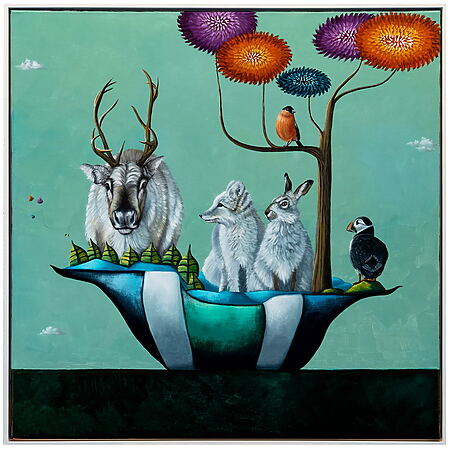Creative painting requires a certain basic equipment. Beginners who have so far gained no or hardly any experience with artists find an insight into the colorful range of colors, papers and canvases in this article.
The decision for the type of colors is particularly elementary, since they have direct influence on the style of painting and the associated challenges in the artistic craft.
Colors for every need
Painting can be lived out with a wide variety of artist colors and each kind brings with it individual properties . Acrylic and watercolor paints are particularly suitable for beginners, whereby watercolor paints require more sensitivity due to the need to save white .
Acrylic paints have the advantage that they can be processed well, can be diluted with water and keep in terms of price. In addition, the colors on plastic dispersion base dry quickly and can then no longer be solved by water. However, this can be seen as an advantage and as a disadvantage when painting - depending on how paintings are developed.

Raising with watercolor paints
Those who want to prefer glazing as a basic technique when painting or at least trying out are well advised with watercolor paints. With the help of the non-covering water-based colors, the glazing creates watercolors with an individual color intensity.
The thin color application can be steamed or reinforced and new colors can mix. The result is the characteristic watercolor impression that shapes many world -famous paintings.
When buying watercolor paints, a few factors must be paid to it in order to enjoy it permanently. In addition to opacity and colored brilliance, the lighting key a significant role.
It is divided into four classes, from the highest to low light resistance ”,
The cfg editorial team explains in the test of 15 of the best watercolor paints. If the colors lack the color of light, they break up by UV light and the pictures fade visibly.
Artist acrylic paints are to be preferred
If acrylic painting a higher pigment share compared to cheaper products and therefore have a better opacity. Watercolor paints are suitable for beginners and particularly cheap.
But acrylic paints are also ideal because their intensity can be designed by dilute. For targeted glazing, acrylic paints are simply mixed more with water. If you cannot choose because of the pure facts, you should take a closer look at the styles of some paintings:
| Acrylic paintings | Under the Bridge (Daniela Schweinsberg), Manifest Success (Kristin Kossi), Calm (Natalia Nosek) - more acrylic painting here . |
| Watercolor | White Ships (John Singer Sargent), garden gate (August Macke), Weimar (E. Memmler) - more in our arrangement for watercolor painting . |

Photo by Craig Adderley, via Pexels
Oil, tempera and gouache
In addition to the watercolor and acrylic paints that are well suited for beginners, there are oil, tempera and gouache colors. Classic oil paints are significantly more expensive than the products that are suitable for beginners and also not exactly harmless in terms of health. The solvents smell strong and well -ventilated rooms are a must to paint.
Tempera colors are available in tubes and contain plenty of preservatives so that they last longer. Many artists therefore make the colors with emulsion and pigments fresh. Temperam paint dries quickly, is durable and rarely forms cracks compared to oil paints.
Nevertheless, these colors also experience and technical knowledge , for example to achieve gentle transitions. Gouache colors combine properties of watercolor and oil paints, contain relatively rough pigments and chalk. The special thing about gouache: dry colors are characterized by a matt surface.

Photo by Steve Johnson, via Pexels
The painting ground: papers and canvases
In order for artist colors to develop their full effect, a suitable painting ground is needed. Paper is ideal for watercolor paints. Special watercolor paper has a rough texture on which the colors adhere evenly. The type of paper is absorbent and either hand -made or industrially produced.
The paper weight moves is usually between 180 and 400 grams. Line walls are rather the exception for watercolors because their absorbency is not comparable to that of watercolor papers.
Acrylic paints are particularly versatile. Every fat -free painting ground is theoretically suitable. These include canvas and wood, but also concrete, metal, painting plates and painting cardboard. For the other colors, the preferred selection is the following:
- Gouache: paper, cardboard, canvas
- Tempera: watercolor and acrylic painting paper, cardboard, canvas
- Oil paints: canvas, wood

Photo by Pavel Danilyuk, via Pexels
Painting with acrylic paints on canvas is very popular among beginners. With a little practice, impressive works of art are created at these painting. The price differences are considerable and the quality for inexperienced is difficult to assess.
In his guide acrylic painter Thomas Guggemos when the investment is worthwhile in high -quality screens and what can be recognized.

Owner and managing director of Kunstplaza. Publicist, editor and passionate blogger in the field of art, design and creativity since 2011. Successful conclusion in web design as part of a university degree (2008). Further development of creativity techniques through courses in free drawing, expression painting and theatre/acting. Profound knowledge of the art market through many years of journalistic research and numerous collaborations with actors/institutions from art and culture.



















